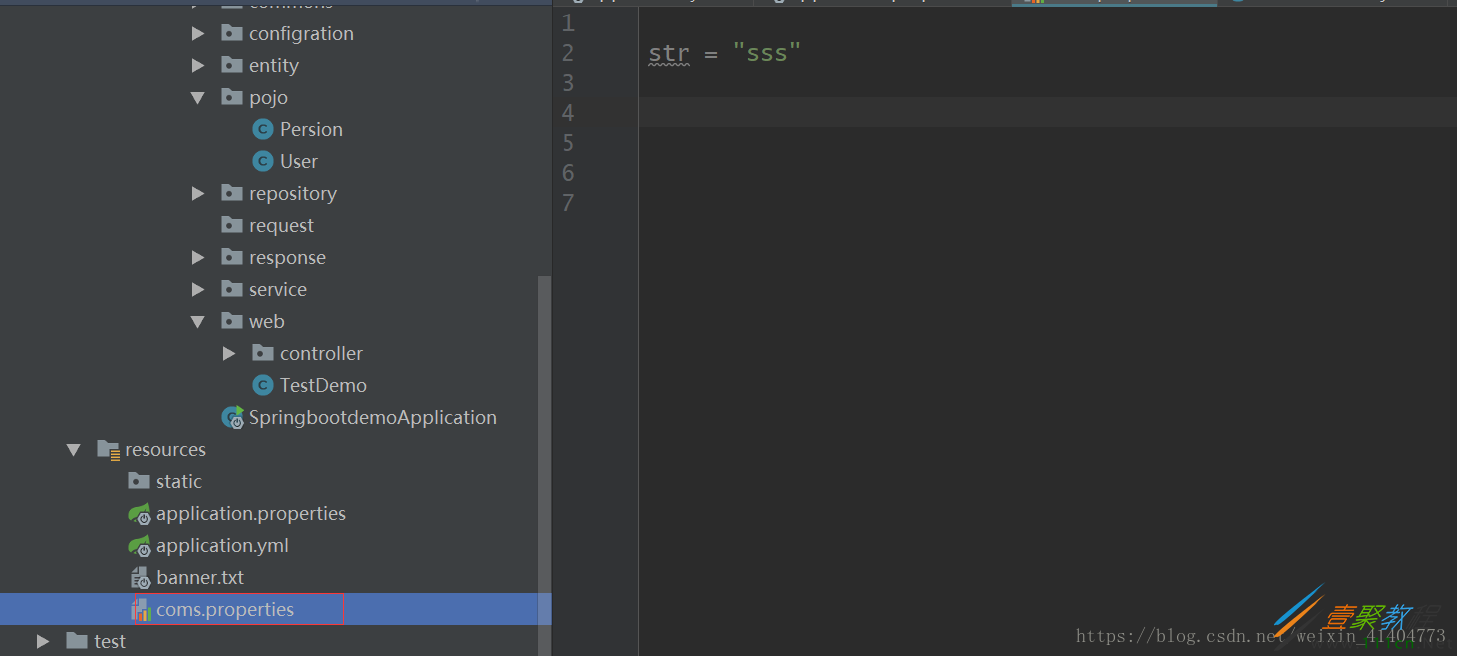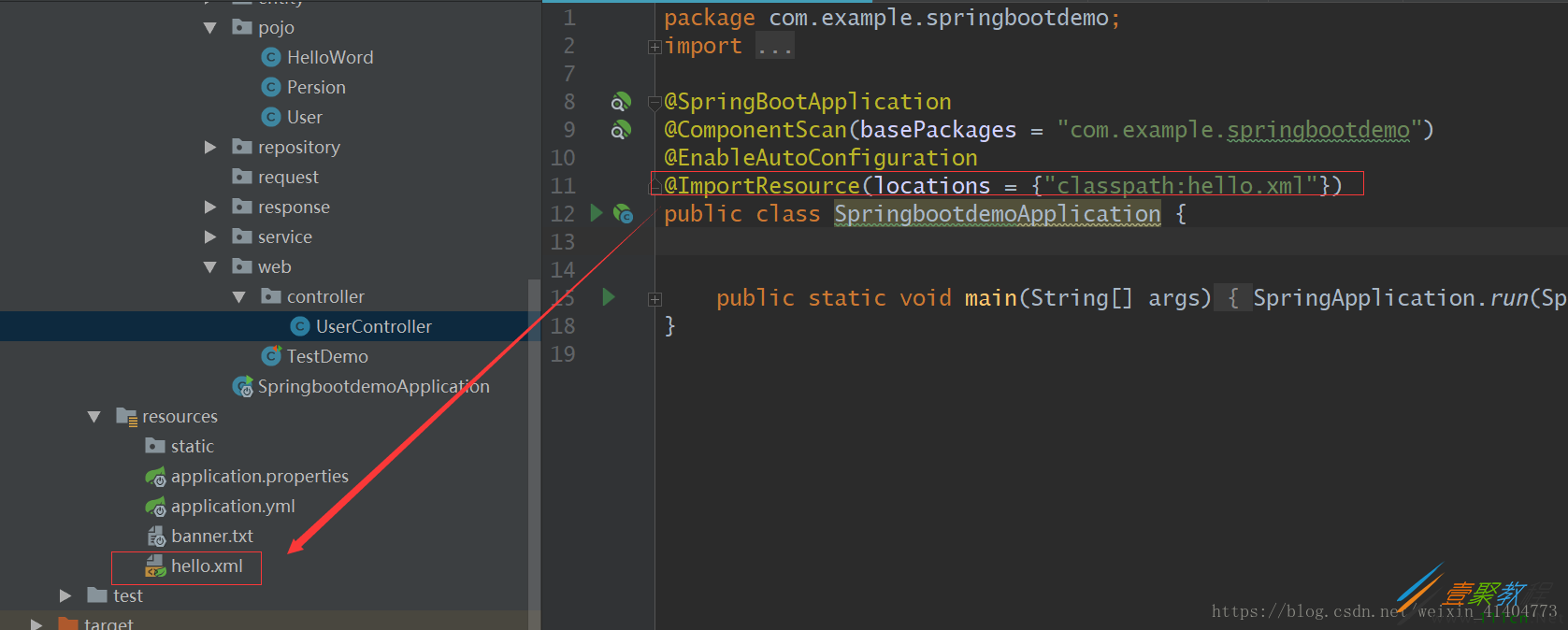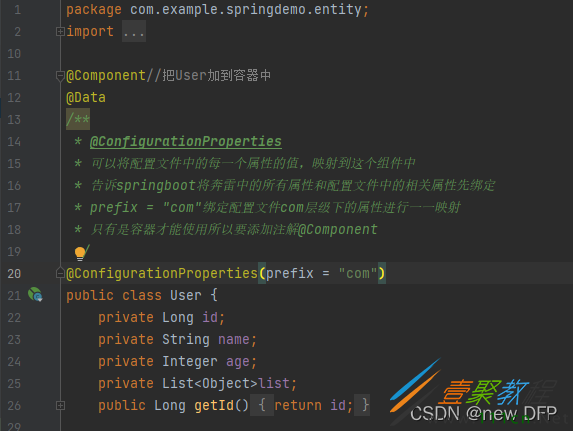使用springboot配置和占位符获取配置文件中的值代码示例
作者:袖梨
2022-06-29
本篇文章小编给大家分享一下使用springboot配置和占位符获取配置文件中的值代码示例,文章代码介绍的很详细,小编觉得挺不错的,现在分享给大家供大家参考,有需要的小伙伴们可以来看看。
@PropertySource& 加载指定的配置文件
package com.example.springbootdemo.pojo;
import com.alibaba.fastjson.JSON;
import org.springframework.boot.context.properties.ConfigurationProperties;
import org.springframework.context.annotation.PropertySource;
import org.springframework.stereotype.Component;
/**
* ***GOOD LUCK****
*
* @Author : Wukn
* @Date : 2018/6/
*
* 将配置文件中的的每一个属性的值,映射到这个组建中
*@ConfigurationProperties
* prefix = "persion" 指定在配置文件中需要将persion的配置属性映射到这个实体类中
*/
/**
* 获取指定配置文件
* @PropertySource( value = {"classpath:coms.properties"})
*/
@Component
/**
* @ConfigurationProperties(prefix = "persion"),默认获取根目录下的值
*/
@ConfigurationProperties(prefix = "persion")
public class Persion {
private String name;
private Integer id;
private Boolean bool;
public Persion() {
}
public String getName() {
return name;
}
public void setName(String name) {
this.name = name;
}
public Integer getId() {
return id;
}
public void setId(Integer id) {
this.id = id;
}
public Boolean getBool() {
return bool;
}
public void setBool(Boolean bool) {
this.bool = bool;
}
@Override
public String toString() {
return JSON.toJSONString( this );
}
}
@ImportResource 导入指定的配置文件
以上方式过于麻烦,springboot推荐通过全注解方式,添加组件的方式
通过注解@Configration申明一个配置类,通过注解@Bean可以使用在方法上面,申明一个组件的生成,要是放在方法上,表明这个方法的返回值放在ioc容器中
package com.example.springbootdemo.configration;
import com.fasterxml.jackson.annotation.JsonAutoDetect;
import com.fasterxml.jackson.annotation.PropertyAccessor;
import com.fasterxml.jackson.databind.ObjectMapper;
import org.springframework.context.annotation.Bean;
import org.springframework.context.annotation.Configuration;
import org.springframework.data.redis.connection.RedisConnectionFactory;
import org.springframework.data.redis.core.RedisTemplate;
import org.springframework.data.redis.serializer.Jackson2JsonRedisSerializer;
/**
* Created with IntelliJ IDEA.
* Description: Cms数据源的一些设置
* Date: 2018-06-08
* Time: 5:50 PM
*
* @author: wukn
*/
@Configuration
public class DataConfig {
@Bean
public RedisTemplate redisTemplate(RedisConnectionFactory factory) {
RedisTemplate template = new RedisTemplate();
template.setConnectionFactory(factory);
Jackson2JsonRedisSerializer jackson2JsonRedisSerializer = new Jackson2JsonRedisSerializer(Object.class);
ObjectMapper om = new ObjectMapper();
om.setVisibility( PropertyAccessor.ALL, JsonAutoDetect.Visibility.ANY);
om.enableDefaultTyping( ObjectMapper.DefaultTyping.NON_FINAL);
jackson2JsonRedisSerializer.setObjectMapper(om);
template.setValueSerializer(jackson2JsonRedisSerializer);
template.afterPropertiesSet();
return template;
}
}
通过占位符获取值
#通过使用占位符赋值
persion.name=张三${random.value}
persion.bool=false
persion.id=12${random.int}
person.last‐name=张三${random.uuid}
person.age=${random.int}
person.birth=2017/12/15 person.boss=false
person.maps.k1=v1 person.maps.k2=14 person.lists=a,b,c
person.dog.name=${person.hello:hello}_dog
person.dog.age=15
springboot配置文件,占位符的使用
首先要给到注解
让user类可用通过配置文件进行实例化
package com.example.springdemo.entity;
import lombok.Data;
import org.springframework.boot.context.properties.ConfigurationProperties;
import org.springframework.context.annotation.Configuration;
import org.springframework.context.annotation.PropertySource;
import org.springframework.stereotype.Component;
import org.springframework.validation.annotation.Validated;
import java.util.List;
@Component//把User加到容器中
@Data
/**
* @ConfigurationProperties
* 可以将配置文件中的每一个属性的值,映射到这个组件中
* 告诉springboot将奔雷中的所有属性和配置文件中的相关属性先绑定
* prefix = "com"绑定配置文件com层级下的属性进行一一映射
* 只有是容器才能使用所以要添加注解@Component
*/
@ConfigurationProperties(prefix = "com")
public class User {
private Long id;
private String name;
private Integer age;
private List
配置文件
[email protected] com.name=newDFP${com.cc:不存在给默认值} com.age=${random.int}
首先就是对age取随机数然后对name获取对象的数据
运行最后一个测试类
package com.example.springdemo;
import com.example.springdemo.entity.User;
import com.example.springdemo.mapper.UserMapper;
import com.example.springdemo.properties.Myproperties;
import org.junit.jupiter.api.Test;
import org.junit.runner.RunWith;
import org.springframework.beans.factory.annotation.Autowired;
import org.springframework.boot.test.context.SpringBootTest;
import org.springframework.context.ApplicationContext;
import org.springframework.test.context.junit4.SpringRunner;
import javax.sql.DataSource;
import java.sql.SQLException;
import java.util.List;
@SpringBootTest
@RunWith(SpringRunner.class)
class SpringdemoApplicationTests {
//如果测试类与启动入口类包名不一致,必须加该注解属性classes指定启动入口类,否则无法启动SpringBoot
@Autowired
private DataSource dataSource;
@Test
public void dataSource() {
try {
System.out.println(dataSource.getConnection());
} catch (SQLException e) {
// TODO Auto-generated catch block
e.printStackTrace();
}
}
@Autowired
Myproperties myproperties;
@Test
void test(){
System.out.println("------------------------");
System.out.println(myproperties.getMes());
}
@Autowired
UserMapper userMapper;
@Test
void testMybatisPlus(){
List users=userMapper.selectList(null);
for (User user:users){
System.out.println(user);
}
System.out.println("查询成功!");
User aduuser=new User();
// aduuser.setName("DFP");
// aduuser.setAge(18);
// aduuser.setEmail("[email protected]");
// aduuser.setId(19053065L);
int i=userMapper.insert(aduuser);
if (i>0){
System.out.println("成功加入记录!");
}else{ System.out.println("失败加入记录!");}
for (User user:users){
System.out.println(user);
}
}
@Autowired
User user;
@Test
public void contextlodes(){
System.out.println("测试结果输出:"+user);
}
}
结果
因为com.cc是不存在的就回去:后面的默认值
如果com.cc存在就会取com.cc的值
测试如下
[email protected] com.name=newDFP+++${com.email:不存在给默认值} com.age=${random.int}
这次的值不再是默认值了com.email是存在数据的
相关文章
精彩推荐
-
 下载
下载孢子2生物进化中文版(Spores)
模拟经营 孢子2生物进化中文版(Spores)孢子2生物进化中文版让我们来做一回疯狂的博士,打造一个属于自
-
 下载
下载叫我万岁爷九游官方版
模拟经营 叫我万岁爷九游官方版叫我万岁爷带你体验当换地点感觉,全新的模拟手游大作让你开始一
-
 下载
下载梦回凤歌
模拟经营 梦回凤歌梦回凤歌手游中你将步入古代的宫廷纷争之中,本想度过美好幸福的
-
 下载
下载洋果子店rose最新版本
模拟经营 洋果子店rose最新版本洋果子店最新版是一款十分容易让人垂涎的开店经营类手游。游戏玩
-
 下载
下载明日大亨最新版
模拟经营 明日大亨最新版明日大亨手游,一个非常经典有趣的模拟经营类型的商战手游,在游




















